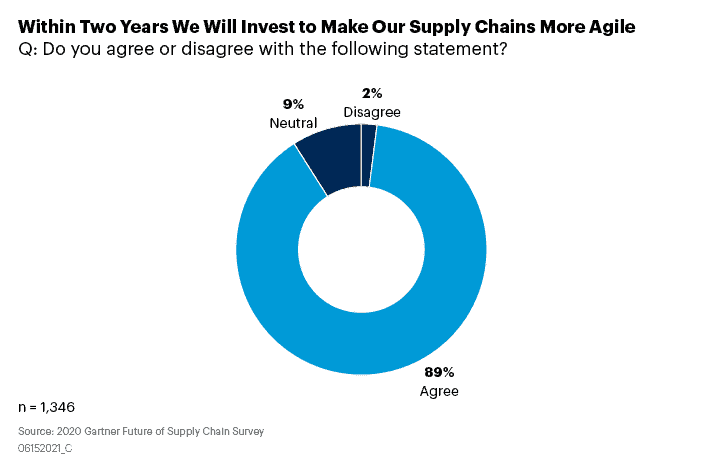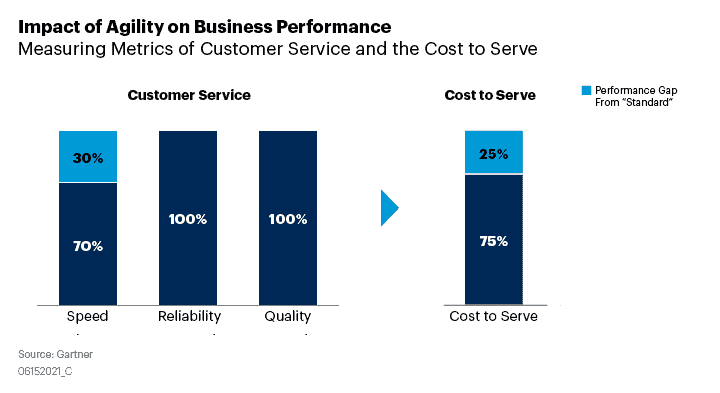For many years, agility has been a buzzword, often perceived as the panacea to all possible supply chain issues. Judging by the many conversations we have had with supply chain executives, there is a lack of clarity and consensus about what agility really means.
Nonetheless, nearly 90% of supply chain leaders who participated in our 2020 annual Future of Supply Chain research said they are planning to invest to make their supply chain more agile over the next couple of years (see Figure 1). Are supply chain leaders staking their future on embodying a quality that isn’t totally clear?

Key misconception about supply chain agility
As any good buzzword, agility comes with a few misconceptions. The most common misconception is that agility is equal to speed. There is not much value in running fast, per se.
What if you respond to unanticipated changes in demand very quickly by expediting? It may be the right thing to do occasionally, but it’s expensive and might not be economically sustainable when it’s common practice.
Or what if you respond quickly, but quality suffers because the wrong product gets shipped? Although speed is valuable, it does not go far enough. Supply chain agility is much more than just running fast.
A second misconception is that agile supply chains are too costly to operate. Over 30% of supply chain executives believe so, according to our research, and refrain from investing to make their supply chain more agile.
However, creating higher levels of agility should not automatically be thought of as being the antithesis of cost-efficiency. In a business world that is volatile, uncertain, complex and ambiguous, an agile supply chain can improve an organization’s ability to limit the downside while capturing upside potential.
Agile supply chains may be more costly to operate, but that cost should be considered like an “insurance” against lost sales or negative impact from disruptions.
The excess cost derived from agility is certainly something to watch out for, but the benefit is an increase in customer service. For the organizations that are able to find this balance, the cost of agility can more than pay for itself by increasing the reliability, quality and speed of customer
How to measure agility?
Agility is the quality of managing unexpected events, those that are impossible to plan in advance. For example, a supply disruption, a sharp decline in demand or an urgent order. Agility is critical because, in most industries, both demand and supply fluctuate more rapidly and widely than in the past.
Measuring the impact of agility on the supply chain is critical too. It means understanding how this attribute is effective in maintaining “standard” supply chain performance, even during a time of change and when unanticipated events occur.
An extremely agile supply chain’s performance won’t be impacted much during a disruptive time. A supply chain that is not sufficiently agile will instead be under pressure when things don’t go as planned.
Agility is an attribute of the supply chain. It is not a business outcome. As such, it cannot be measured, per se. What companies can measure is the impact of agility on the business performance.
Higher levels of agility can positively impact customer experience in terms of speed, reliability and quality of service. However, it can also impact the cost to serve.

Measuring the impact of agility on business performance, therefore, requires measuring metrics assessing the level of customer service (i.e., speed, reliability and quality of service), and the cost to serve.
Supply chain leaders should monitor performance to determine if the level of agility is sufficient. If not, they should analyze performance variations associated with unanticipated events that occurred (e.g., a supply disruption) and the responses the supply chain undertook (e.g., expediting).
Supply chain leaders should weigh the costs that agility brings against the increase it delivers on the customer service level to determine if they have the right level of agility. The degree of agility needed will depend on how much a company wants to “insure” its supply chain against possible risks.
We are working on a set of metrics and a dashboard that will help supply chain leaders measure the impact of agility on supply chain performance. Check out gartner.com over the coming weeks!
Pier Manenti
VP Analyst
Gartner Supply Chain
First published on Gartner blog network





